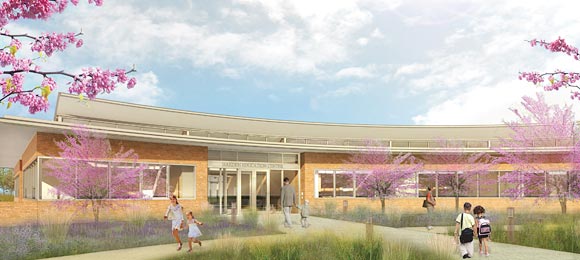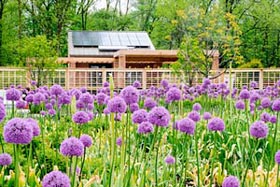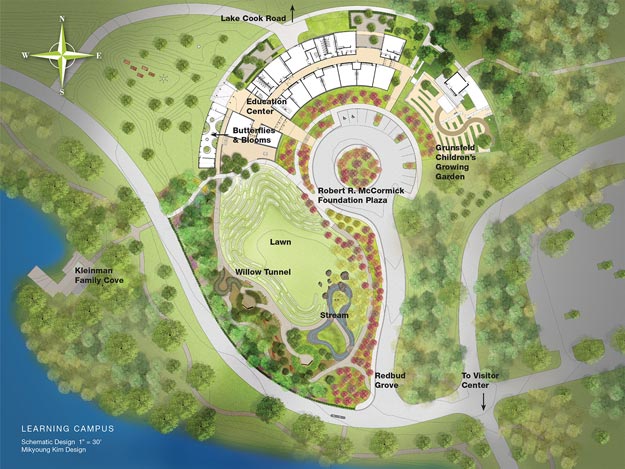The new seven-acre Regenstein Learning Campus, which opened in September 2016, advances the Chicago Botanic Garden's influence as a science and education institution.
Since the Chicago Botanic Garden opened to the public in 1972, children and adults alike have benefitted from nature experiences throughout its 385 acres, and participated in countless plant-based programs. This year, the Garden’s legacy of learning grows even stronger as the Regenstein Learning Campus welcomed students and visitors of all ages.
The seven-acre Regenstein Learning Campus is a center of inspiration, education, and training for nature-lovers and the next generation of plant scientists, educators, and land stewards. It functions as a hub of social and educational activity for civic engagement, plant-based intergenerational learning, hands-on coursework, and a range of health and wellness activities. Most of all, it is a gathering place, designed to connect people with plants and to generate excitement and curiosity about the natural world.
Building on its Core strengths
The Chicago Botanic Garden leads public gardens in the scope and depth of its education programs. The Regenstein Learning Campus builds on these core strengths by enhancing existing programs and engaging new audiences in an expanded, welcoming learning environment. Among other things, the Learning Campus significantly extends the Garden’s commitment to early childhood education and enables it to train a wide audience of early childhood caregivers and educators in the developmental theory and practice of nature play.
As the Garden’s new home base for education, the Campus facilitates connections between people and nature by offering plant-based immersive experiences along a lifetime pathway of programs rare in the museum world. From babies through older adults, program participants at the Campus will benefit from an array of programs taught by leaders in fields ranging from early childhood nature play to horticulture to yoga.
The Regenstein Learning Campus includes the Robert R. McCormick Foundation Plaza and entry drive, the Kleinman Family Cove, and the Grunsfeld Children’s Growing Garden. The Learning Center and Nature Play Garden complete the Campus.
THE learning CENTER
The Learning Center, featuring 12 classrooms—two dedicated to early childhood development—and a nature laboratory for students to investigate plants, anchors the Regenstein Learning Campus. The educational and hugely popular Butterflies & Blooms exhibition will become a permanent feature of the Learning Center, continuing to delight young and old alike. With the light-filled Astellas Atrium providing an entrance and a venue for interpretive artwork, an observational beehive introducing visitors to the pollinator story, and peek-through windows showing the internal mechanics of the building’s sustainability features, the Learning Center is a destination for Garden visitors. It also serves as headquarters of the Joseph Regenstein, Jr. School of the Chicago Botanic Garden and an innovative Nature Preschool that opened its doors in September 2016.



The nature play Garden
A multisensory discovery garden, the Nature Play Garden invites the sort of nature play so essential to instilling an appreciation of plants and the natural world in the young and the young-at-heart. Visitors of all ages and abilities appreciate the garden’s beautiful, engaging, play-inspiring landscape of trees, grass, water, flowers, rocks, logs, and places for exploring. Renowned landscape designer Mikyoung Kim provided the concept vision for the Nature Play Garden; Jacobs/Ryan Associates is adapting the concept into a design that will incorporate native plants, and all materials are of local and sustainable manufacture, such as granite sourced from Minnesota.
The Nature Play Garden includes sugar maple, aspen, and redbud groves, an expansive lawn that gently slopes downward with sculpted landforms, a willow tunnel, and “rooms” of arborvitaes and hornbeam. A runnel looping around the lower floodplain features large boulders and “loose parts” play areas to encourage nature-play. Natural landforms and mown paths encourage parents to allow even their smallest children to freely explore the area. The Nature Play Garden, including a terrace connecting it to the Learning Center, exemplifies the plant-centered outdoor classroom concept.
From Fledglings to Empty Nesters and Beyond
Early Childhood Programs
The Regenstein Learning Campus is uniquely designed and staffed to engage all learners, including the youngest. The thoughtfully designed space, indoors and outside, creates exciting opportunities for new plant-based programs, including the Nature Preschool. Existing popular programs such as My First Camp and Little Diggers may expand, diminishing or even eliminating waitlists. Early childhood training programs may grow as well, helping caregivers and educators to develop tools for engaging children with nature, and enabling these adults to bring the value of nature-play activities to a much broader audience.
Most important of all, children on the Regenstein Learning Campus play. They observe how plants respond to seasonal changes; discover a myriad of insects and animals that dwell in this habitat; crawl through and over hollow trees; listen to wind rustling tree leaves; create structures with pinecones, sticks, and stones; run up and down hills; and splash in streams. These play experiences enable them to discover and appreciate nature using all of their senses. For as children play, they learn. Author Richard Louv coined the term “nature-deficit disorder” to describe the consequences of an absence of nature in children’s lives; through its innovative Regenstein Learning Campus, the Chicago Botanic Garden aims to close this education gap.
Read about the Grunsfeld Children's Growing Garden, the Kleinman Family Cove, and the Learning Center. Butterflies & Blooms will become a permanent part of the Learning Center in 2017.
The Regenstein Learning Campus is made possible by the generous support of the Regenstein Foundation, others listed below, and many other contributors.
The Learning Center and Nature Play Garden are made possible by the generous support of the Grainger Foundation; Astellas USA Foundation; Arthur D. Collins, Jr., and the Collins Family Foundation; the Hunter Family; Illinois Clean Energy Community Foundation; ITW; an anonymous donor; the Woman's Board of the Chicago Horticultural Society; the Public Museum Capital Grants Program, Illinois Department of Natural Resources, Illinois State Museum; the Harris Family Foundation, and Cate and Rick Waddell.
Funding for the Robert R. McCormick Foundation Plaza and entry drive was provided by the Robert R. McCormick Foundation and the U.S. Department of Transportation, Federal Highway Administration.
The Grunsfeld Children's Growing Garden is made possible through the generosity of Esther Grunsfeld Klatz and Ernest A. Grunsfeld III; the Robert R. McCormick Foundation; the Guild of the Chicago Botanic Garden; and the Public Museum Capital Grants Program, Illinois Department of Natural Resources, Illinois State Museum.
The Kleinman Family Cove is made possible by the generous support of the Annette and Bernard Kleinman Family.



